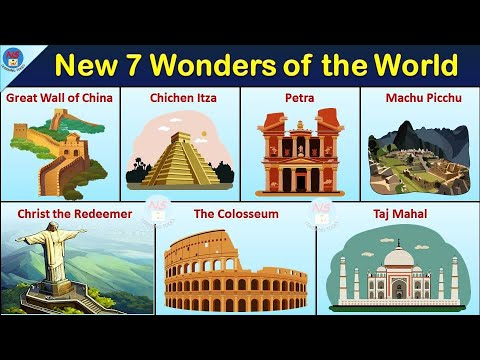The concept of the “Seven Wonders of the World” has evolved over time, encompassing both ancient marvels and modern achievements. These wonders represent the pinnacle of human ingenuity, artistry, and architectural prowess. Here, we explore both the ancient and modern lists of wonders that capture our imagination and symbolize our collective heritage.
Ancient Wonders
- Great Pyramid of Giza (Egypt)
- The only surviving wonder from the original Seven, the Great Pyramid was built around 2580–2560 BC as a tomb for the Pharaoh Khufu. This massive structure, composed of approximately 2.3 million blocks of stone, exemplifies the ancient Egyptians’ architectural skill and their understanding of mathematics and astronomy.
- Hanging Gardens of Babylon (Iraq)
- Described as an extraordinary series of tiered gardens containing a wide variety of trees and plants, the Hanging Gardens are said to have been built in the ancient city-state of Babylon, near present-day Hillah, Babil. Despite their fame, the existence of these gardens remains a subject of debate among historians.
- Statue of Zeus at Olympia (Greece)
- Crafted by the sculptor Phidias around 435 BC, this giant statue of the god Zeus stood over 12 meters (39 feet) tall and was made of ivory and gold-plated bronze. Located in the Temple of Zeus in Olympia, it was a testament to the artistry of ancient Greece and a focal point of the Olympic Games.
- Temple of Artemis at Ephesus (Turkey)
- This grand temple, dedicated to the goddess Artemis, was rebuilt around 550 BC after being destroyed. It was renowned for its impressive size, intricate sculptures, and beautiful artwork. The temple was considered one of the largest and most splendid temples of the ancient world.
- Mausoleum at Halicarnassus (Turkey)
- This monumental tomb, built for Mausolus, a satrap of the Persian Empire, around 350 BC, stood approximately 45 meters (148 feet) high and was adorned with sculptural reliefs. The term “mausoleum” is derived from Mausolus’ name, reflecting the structure’s significance in history.
- Colossus of Rhodes (Greece)
- Erected around 280 BC, this massive statue of the sun god Helios stood approximately 33 meters (108 feet) tall, overlooking the harbor of Rhodes. The statue symbolized the unity of the islanders and their triumph over an invading army, but it stood for only 56 years before being toppled by an earthquake.
- Lighthouse of Alexandria (Egypt)
- Also known as the Pharos of Alexandria, this impressive lighthouse was built on the small island of Pharos around 280 BC. It stood approximately 100 meters (330 feet) tall and served as a prototype for all subsequent lighthouses. Its light guided sailors safely into the harbor of Alexandria.
Modern Wonders
In 2007, the New7Wonders Foundation conducted a global poll to establish a new list of wonders representing contemporary achievements. The result was:
- Great Wall of China (China)
- Stretching over 13,000 miles, the Great Wall was built over several dynasties to protect against invasions. Its construction showcases remarkable engineering and architectural skill.
- Petra (Jordan)
- This ancient city carved into rose-red cliffs is known for its rock-cut architecture and water conduit system. Petra served as a trading hub and is a symbol of Jordan’s rich history.
- Christ the Redeemer (Brazil)
- Standing atop Corcovado Mountain in Rio de Janeiro, this iconic statue of Jesus Christ symbolizes peace and welcoming. Completed in 1931, it stands 30 meters (98 feet) tall, with an arm span of 28 meters (92 feet).
- Machu Picchu (Peru)
- An ancient Incan city set high in the Andes Mountains, Machu Picchu is renowned for its archaeological significance and stunning terraced landscapes. It showcases advanced engineering and agricultural practices.
- Chichen Itza (Mexico)
- This large pre-Columbian archaeological site was a major city of the Maya civilization. The Pyramid of Kukulcán, its centerpiece, is known for its astronomical significance, particularly during equinoxes.
- Roman Colosseum (Italy)
- An iconic symbol of ancient Rome, the Colosseum was completed in AD 80 and could hold up to 80,000 spectators. It was used for gladiatorial contests and public spectacles, showcasing Roman engineering and architectural innovation.
- Taj Mahal (India)
- Built in the 17th century by Emperor Shah Jahan in memory of his wife Mumtaz Mahal, the Taj Mahal is an exquisite example of Mughal architecture. Its white marble facade and intricate inlay work make it one of the most beautiful buildings in the world.
Conclusion
The Seven Wonders of the World, both ancient and modern, serve as a testament to human creativity and the desire to leave a lasting legacy. They remind us of our shared history and the incredible achievements that can arise from our collective imagination and labor. Whether standing the test of time or reflecting contemporary culture, these wonders inspire awe and admiration, inviting future generations to explore and appreciate our world’s remarkable heritage.
Read more :
1= https://rapidurlindexer.net/blogs/what-are-the-primary-colors/
4= https://rapidurlindexer.net/blogs/the-ten-commandments-a-moral-foundation/
5= https://rapidurlindexer.net/blogs/what-are-the-seven-continents/



